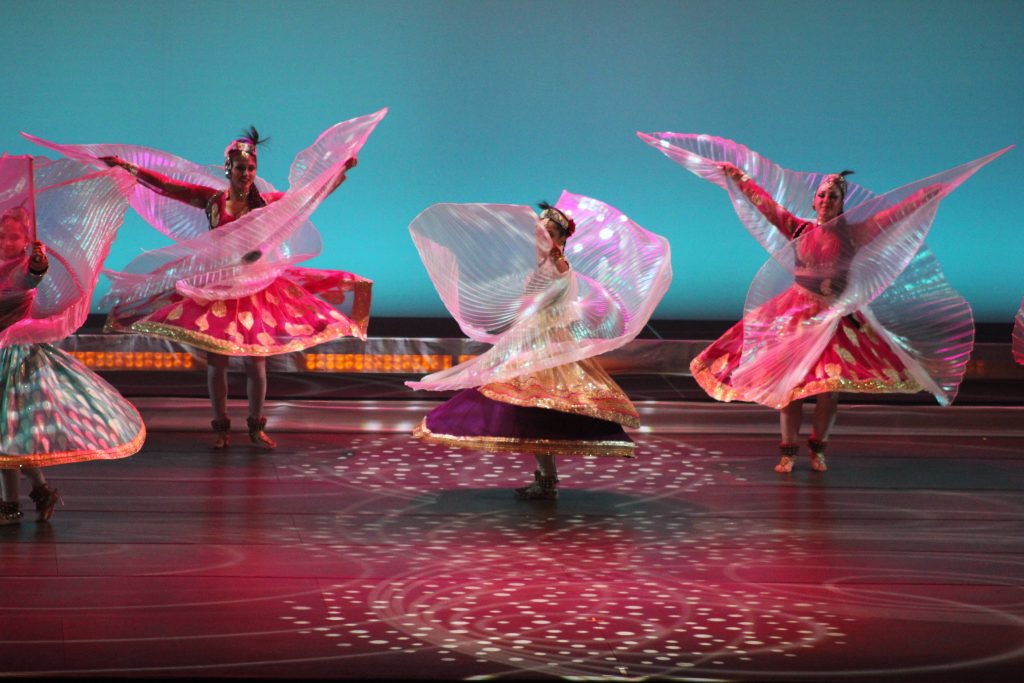The Osterhout Concert Theater on Sunday hosted “Rhythm India: Bollywood & Beyond,” a celebration that took audiences on a journey through Indian song, dance, love and joy. The performance included a variety of Indian dances — including traditional forms that have lasted across time — popular numbers featured in Bollywood cinema, and folklife dances that celebrate community and love, and audiences were invited to enjoy the show as they learned more about the meaning of dance in Indian cultures.
Choreographed and directed by World Choreography Award nominee and Telly Award-winning director and choreographer Joya Kazi, “Rhythm India: Bollywood & Beyond” was performed by dancers from the Joya Kazi Unlimited dance company. With a runtime of around two hours, the show was made up of seven acts and featured multiple Indian dance forms, including the classical form of Kathak dance from north India, Punjabi Bhangra and the Indian classical dance of Manipuri.
The narrator of “Rhythm India,” Mayurii Vasan, emphasized the integral role song and dance play in the celebration of Indian culture throughout the performance and told stories of love, community and family — or as she put it, important tenets of Indian culture — that were reflected in each dance number. The show further embraced the variety in Indian spiritual culture through dance by including traditional forms from the Muslim and Hindu religions, along with sequences that originate in village folk practices and the Mughal era.
Aishani Misra, a freshman majoring in economics, expressed how meaningful the performance was for her as someone who also practices Indian dance.
“I started learning dance when I was in kindergarten, like Bharatanatyam,” Misra said. “My mom put me in it to connect to my culture and I really want to join the dance team here too in the future.”
Amid the colorful, vibrant costumes and dynamic music, the show was both entertaining and informative and gave the audience insight into different ways dance has been practiced in India as a way of maintaining connection across time, space and faith. “Rhythm India” allowed audiences to witness Indian dance from across time and space as dancers brought to life recognizable forms from the world’s largest film industry and told stories of everyday village life, from festive kite flying to home remedies.
A few select acts included “Kismat — A Bollywood Destiny,” “Ghungroo Ki Awaaz — The Voice of the Dance Bells” and “Dholna — Folk Rhythms,” in addition to acts that centered around love, including “Taare Zameen Par — Stars Among Us” and other classic forms.
“There was a portion where they had four different types of Indian dance that come together, and they were dancing on stage together,” Misra said. “So that was cool to watch the [converging] of all parts of India together like that.”
“Rhythm India” also gave the audience additional insight into different ways Indian dance has been practiced politically. The third act, “Satrang — Colors of Classical Dance,” narrated the secret use of dance forms during British colonial rule, when cultural dance practices were banned as a way of establishing control. Bridging modern-day Indian cinema with stories of the past, the cast and crew worked tirelessly to immerse the audience in a swirling journey through Indian performance art.
Matthew Honan, a student technician for the “Rhythm India” set and a senior majoring in theatre, directed the different lighting and signal cues that painted expressive backdrops out of neon lights, shone spotlights on solo performers and helped enhance the full effect of the different dance sequences. Honan has worked on more than one set at the Anderson Center and had nothing but positive things to say about the show.
“The stage manager who came in with ‘Rhythm India,’ she was incredible,” Honan said. “If I happen to come across her or anyone like her again, I would be more than excited.”
Every member of the Joya Kazi Unlimited dance company that performed during “Rhythm India” was met with resounding applause from the audience and attendees were able to meet a few of the dancers outside of the theater space after the show.



